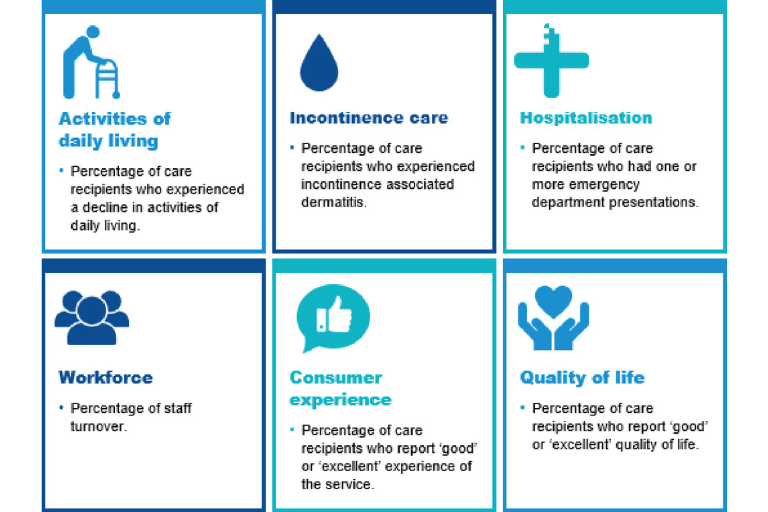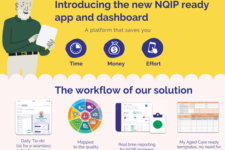
Since the implementation of The National Aged Care Mandatory Quality Indicator Program (QI Program) in 2019, The Department of Health and Aged Care (Department) has required all Residential Aged Care providers to collect data and report on a set of Quality Indicators (QIs) every three months.
The purpose of the program has been to improve quality, while also supporting providers to achieve better health outcomes for consumers in their care.
The QI Program currently requires residential aged care providers to report on five areas of care including: pressure injuries, physical restraint, unplanned weight loss, falls and major injury, and medication management.
Consistent with the recommendations of the Royal Commission into Aged Care Quality and Safety, the QI program is all set for an expansion to a total of 11 quality indicators. These crucial six new quality indicators will be introduced from April 2023 and reported by all approved providers of residential aged care in July 2023.
The six new indicators are:
- Activities of daily living (ADL): percentage of care recipients whose ADL function has declined
- Continence: percentage of care recipients with incontinence associated dermatitis
- Hospitalisations: percentage of care recipients who presented to hospital
- Workforce: percentage of staff turnover
- Consumer experience: percentage of care recipients who report good or excellent experience of the service
- Quality of life: percentage of care recipients who report good or excellent quality of life

The sector is well versed in the reporting of clinical indicators to measure service performance however, resident experience at most has been only 10-15% by assessors during accreditation and not had much weightage. As part of this new spectrum of Quality Indicators, customer experience and quality of life measurement has earned a vital spot in the measurement of provider’s performance.
The fact that we’re having customer voice /experience as part of the expanded QI program is something that is important moving forward for the aged care sector in Australia. The aim is not to be punitive, but to provide aged care providers with the opportunity and ability to measure and monitor their performance against these key indicators and drive continuous quality improvements.
Let’s take a deeper dive into the two Quality Indicators that involve consumer surveys
The QCE-ACC (Quality of Care Experience Aged Care Consumers) and QOL-ACC (Quality of Life Aged Care Consumers) tools are designed to measure residential aged care outcomes and deliver on these additional indicators to promote best practices.
The QCE-ACC includes six questions focusing on key attributes to the quality of care experience and the QOL-ACC includes six questions focusing on key attributes of quality of life.
So, what are the mandatory collection requirements?
- 100% of residents every quarter need to be offered feedback
- Residents when providing feedback need to be recorded into one of the following categories: “completed survey” “absent from care”, “refused”or “sent to proxy”
- Residents must have the right to remain anonymous, but you would still need to calculate an individual score
- If a resident can’t complete themselves due to cognitive impairment you must send a proxy. Providers need to record proxy completion of surveys
In order to meet the collection and reporting requirements, the Department is asking providers to utilise their own staff to survey 100% of their residents each quarter.
While this has been branded ‘feasible to implement’ by the Department, there are challenges associated if you are not using a NQIP friendly survey tool.
Here are some of the challenges to overcome:
- Tracking which residents have given feedback
- Allowing residents to remain anonymous, but calculating an individual score
- Sending and tracking proxy completion of surveys
- Resourcing the collection of feedback for all residents who are capable of responding
- Resourcing to collate and calculate the data to report each quarter
For providers that are new to regular feedback collection, shifting to quarterly resident feedback collection will require substantial change management projects over the first 12 months. Increasing workloads on an overstretched workforce has the potential to create a greater admin burden for frontline and middle management.
The areas for improvement on the QCE-ACC and QOL-ACC flagged by providers during pilot phase.
While it’s not clear what changes have taken place following the initial pilot of the quality indicators, outlined below are some of the areas of improvement flagged from providers to the Department.
The Department’s findings website states that after the six-week pilot, survey participants confirmed the new quality indicators were ‘easy to understand and feasible to implement’.
But the most significant area to address is the inability to skip a question without it negatively impacting that home’s overall score, in the event a resident refuses to answer that question.
A further challenge raised by providers is that it creates scenarios where providers can have lower scores due to resident’s lack of understanding a question, or finding it not applicable to their experience. This can result in skewed data as staff may feel inclined to respond on resident’s behalf to avoid penalisation from a skipped question.
The questions within the surveys itself were flagged as a concern, stating that many residents found the surveys difficult to understand, not applicable in some instances to residents (such as pain) and repetitive in nature.
Challenges around the provider being able to impact change on a question set that they have very little control over (particularly under the current funding arrangements) to do anything about improving it.
As mentioned above it’s unclear if this feedback will result in any improvements to the tool. Which typically is how pilots and co-design with sector works.
The reporting on consumer experience is going ahead
Regardless if you agree or not, consumer experience reporting is going ahead. With the festive season and New Year fast approaching it doesn’t provide a great deal of time to get your system in order.
Given there will be a total of 11 mandatory quality indicators to report on, each indicator demands having its own specific reporting template.
Providers where possible should look to automate as much of the reporting as possible.
If you are looking to automate Consumer Experience and Quality of Life indicators please get in touch with CarePage.














